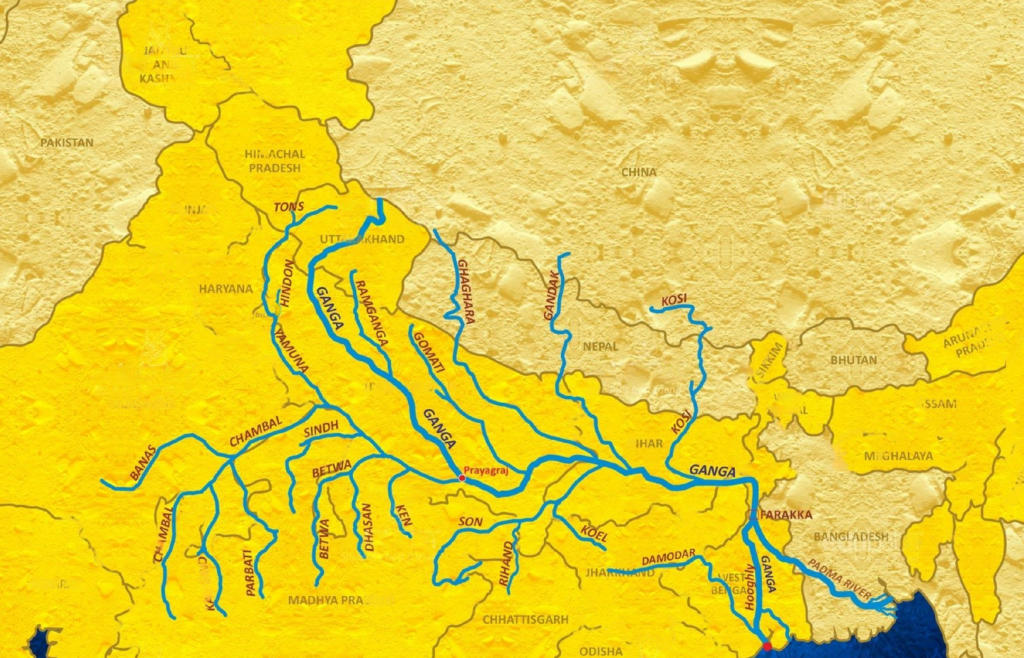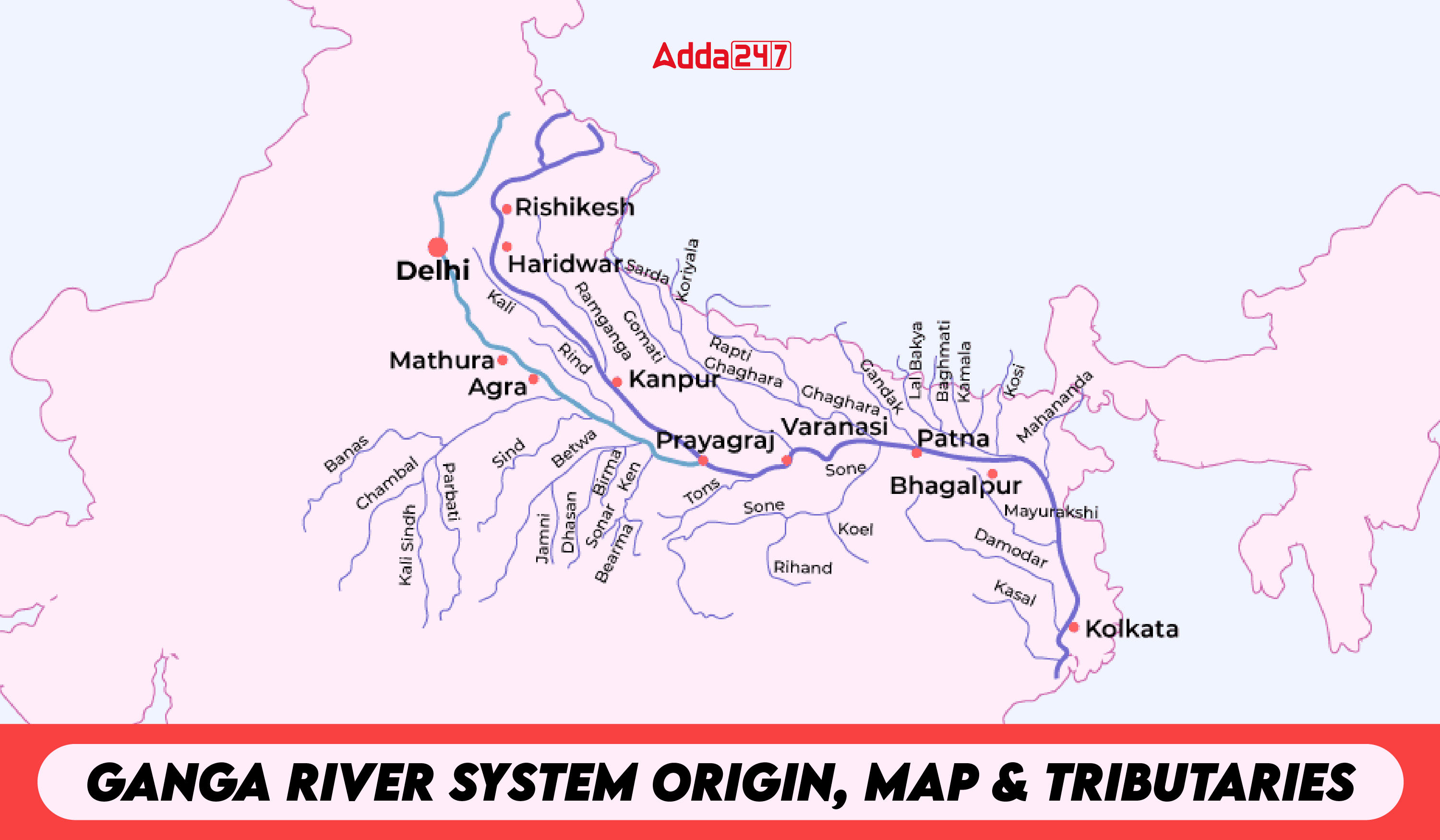Table of Contents
The Ganga is the longest river in India. The Ganga plays a very important role in northern India. The origin of the Ganga River is from the Gomukh glacier in Uttarkashi of Uttarakhand. The Ganga River system, the lifeline of millions of people in North India, flows through the heart of India. It nurtures ancient civilizations, diverse cultures, and rich biodiversity during its sacred journey from the glaciers of Uttarakhand to the Himalayas and the Bay of Bengal.
Ganga River System
For the UPSC exam, the Ganga River system is very important. India’s oldest river is this one. The Ganga River is first noticed in the Indian state of Uttarakhand, where it originates. The Gangotri Glacier in the Himalayas is the primary source of the Ganga. West Bengal, Bihar, Uttarakhand, and Uttar Pradesh are all along the Ganga River. The system of the Ganga River. With numerous tributaries entering it, the Ganga river system is one of the most significant water systems in India. It is significantly more extensive and significant since it contains the fusion of minor and large rivers, like the Yamuna.
| Ganga River system |
| The Ganges River: One of the world’s great rivers, flowing from the Himalayas to the Bay of Bengal, through northern India and Bangladesh. It’s a major source of water and fertile land for millions.
Importance in Hinduism: The Ganges is considered the holiest river in Hinduism. Hindus believe bathing in its waters washes away sins, and many go on pilgrimages to holy sites along its path. Length and Basin: The Ganges is 1,557 miles (2,506 km) long, with a basin spanning 376,800 square miles (975,900 square km). Its width ranges from 200 to 400 miles (325 to 650 km). Source and Flow: The main source of the Ganges, called Bhagirathi, starts in the Himalayas. It flows southeast, receiving water from many tributaries, including the Yamuna River near Allahabad. Delta and Tributaries: The Ganges empties into the Bay of Bengal, forming a huge delta with the Brahmaputra River. This delta is the largest in the world, mostly in Bangladesh. Rain and Flooding: The Ganges basin gets heavy monsoon rains (30–90 inches per year). Flooding from the river is common and can be deadly, especially in the delta. Strong cyclones also hit the region. Population and Agriculture: The Ganges basin is densely populated and heavily farmed. Irrigation has made it an important agricultural area, growing wheat, sugarcane, cotton, and oilseeds. Historical Importance: The Ganges was once a vital transport route. Today, river traffic is limited, but it’s still used for transporting goods in rural areas of India and Bangladesh. Major Cities: Importnat cities along the Ganges include Kolkata, Varanasi, Allahabad, and Kanpur. Varanasi and Allahabad are especially holy in Hinduism, with temples and ghats where pilgrims bathe or scatter ashes. |
Origin of River The Ganga
The river Ganges originates from the Gomukh glacier (3900 m) of Gangotri and is known as Bhagirathi. When the ice of this glacier melts, it becomes the clear and cool water of the Bhagirathi River. As the Bhagirathi River flows down from the heights of the Himalayas, it later meets the Alaknanda at Devprayag and then it is officially known as the Ganga River only after this confluence. This confluence point of the Ganga transforms it into a sacred and mighty stream.
| Course of the Ganga River |
|
Ganga River System Map
Ganga has many tributaries, and understanding them all by just reading can be a big challenge. Given this complexity, understanding all the tributaries of the Ganga through a map is not only simpler but also more effective. A map clearly shows us the flow of different rivers, their confluence points, and their relationship with the Ganga. From this perspective, using the map we can understand the overall information of all the tributaries of Ganga more easily and accurately, as displayed below.

Why is Ganga considered sacred from a religious point of view?
According to Hindu mythology, it is believed that Ganga was sent to earth by Lord Shiva to purify the souls of the living and the dead. For centuries, religious Hindus have been bathing in the Ganges to purify their souls and the souls of their ancestors. According to Hindu religious scriptures, it is believed that immersing the ashes of dead people in the Ganga gives peace to the soul of the deceased.
Ganges Entrance in Indian states- Ganga River System
The Ganga River, an important river of North India, flows through many states of India and starts from Uttarakhand.
- Uttarakhand- Ganga River first originates from Gangotri Glacier in the Himalayas of Uttarakhand, although initially this river is called Bhagirathi, until it merges with Alaknanda at Devprayag. After meeting Alaknanda at Devprayag, the confluence of both forms Ganga.
- Uttar Pradesh – The entry point of the Ganga River to the plains is at Haridwar in Uttarakhand. After this, in Uttar Pradesh, this river flows through major cities like Rishikesh, Haridwar, Kanpur, Allahabad (Prayagraj) and Varanasi. Prayagraj has a special status in Uttar Pradesh where there is Triveni Sangam, which is the confluence of Ganga, Yamuna, and the mythical Saraswati River.
- Bihar– After Uttar Pradesh, the Ganga River enters Bihar. The entrance of Ganga River in Bihar enters Bihar near Chausa in the Buxar district, after which it flows through important cities like Patna, Munger, Bhagalpur, and Begusarai. The state capital Patna has immense historical and cultural significance. After Bihar, the river touches Jharkhand near Sahibganj district before entering West Bengal near Rajmahal in Murshidabad district.
- West Bengal- In West Bengal, the Ganges passes through cities like Murshidabad, Kolkata and Howrah. In West Bengal, the Ganges River splits into two main parts: the Hooghly River, which flows through Kolkata, and the Padma River, which flows further into Bangladesh. Finally, the Ganges reaches the Bay of Bengal, where it forms the Sundarban Delta, one of the largest river deltas in the world.
Also Read: Yamuna River System
Tributaries of the Ganga – River System
The Ganga is the longest river in India and it has many tributaries like Yamuna, Son, Ghaghara, Gandhak, Koshi, and many more. The tributaries of The Ganga are divided into two parts, the first part is called the right bank tributaries of The Ganga and the second part is called the left bank tributaries of The Ganga.
| The major tributaries of the Ganges River |
| Yamuna: The largest tributary of the Ganges, it joins the Ganges at the Triveni Sangam in Prayagraj (Allahabad), Uttar Pradesh. Ghaghara (Karnali): Originates in Tibet, flows through Nepal, and joins the Ganges in Uttar Pradesh. Gandak: Starts in Nepal, flows through Bihar, and meets the Ganges in Bihar. Kosi: Also begins in Nepal, flows through Bihar, and joins the Ganges in northern Bihar. Son: Originates in the Vindhya Range in Madhya Pradesh, flows through Bihar, and merges with the Ganges near Patna. Tungabhadra: Starts in the Western Ghats, flows through Karnataka and Andhra Pradesh, and indirectly connects to the Ganges through the Krishna River. Mahananda: Begins in the Darjeeling hills, flows through West Bengal and Bihar, and joins the Ganges near Kaliachak in West Bengal. These tributaries add water and sediment, helping to create the Ganges’ fertile basin. |
River System Right bank tributaries of The Ganga
The Ganga has many right bank tributaries but some of the most important tributaries of The Ganga are Yamuna, Son, Chambal, ton, Punpun, Betwa, Sindh, and many more.
- Yamuna- Yamuna is the biggest tributary river of The Ganga. The origin of Yamuna is from Yamunotri Uttarkashi. The length of Yamuna is 1376 kilometers. The confluence of The Ganga and Yamuna takes place at Prayagraj, Uttar Pradesh. Yamuna has also many tributaries like Chambal, Ken, Betwa, Sengar, Sindh, Hindan, Rind, Varuna, etc
- Chambal- The origin of Yamuna from Janapav Hills of Vindhya Range, Madhya Pradesh. The length of Chambal is 960 kilometers. The tributaries of Chambal is shipra and banas.
- Tons- The Tons River Originates from the Bandarpunch Glacier at the height of 6,315 meters in the western Himalayas. Tons has an approximate length of about 148 kilometers (92 miles). Tons River is the tributary of Yamuna and does not directly confluence with the Ganga
- Betwa- Betwa originates from the Vindhya mountain range in Madhya Pradesh. The length of Betwa is 610 kilometers (380 miles). Betwa River meets Yamuna River, not The Ganga. Betwa River is a tributary of Yamuna and does not join The Ganga directly. Betwa confluence with The Ganga takes place near Hamirpur city in Uttar Pradesh state.
- Son- The Origin of Son River is near Amarkantak in Madhya Pradesh. The Son River is a major southern tributary of the Ganges River. The length of Son is 784 kilometers (487 miles). Son River passes through the Kaimur mountain range and joins the Ganga at Patna (Bihar).
- Sindh- Sindh Originates in the Malwa Plateau, Madhya Pradesh. Tons has an approximate length of about 470 kilometers (290 miles). Sindh River is the tributary of Yamuna and does not directly confluence with the Ganga. The confluence of the Sindh River with the Yamuna takes place at Pachnada town in the Etawah district of Uttar Pradesh.
- Punpun- The Origin of punpun river in the Chotanagpur Plateau, Jharkhand. The length of the punpun is 200 kilometers (120 miles). Punpun confluence with the Ganga is located near Fatuha, in the Patna district
|
Right bank tributaries of The Ganga |
|||
| Right Bank Tributaries | Origin | Length | Confluence |
| Yamuna | Yamunotri, Uttarkashi | 1376 km | Prayagraj, Uttar Pradesh |
| Chambal | Janapav Hills, Vindhya Range, Madhya Pradesh | 960 km | Yamuna River |
| Tons | Bandarpunch Glacier, Western Himalayas | 148 km | Yamuna River (not directly with Ganga) |
| Betwa | Vindhya Mountain Range, Madhya Pradesh | 610 km | Near Hamirpur city, Uttar Pradesh (with Yamuna) |
| Son | Near Amarkantak, Madhya Pradesh | 784 km | Patna, Bihar |
| Sindh | Malwa Plateau, Madhya Pradesh | 470 km | Pachnada town, Etawah district, Uttar Pradesh (with Yamuna) |
| Punpun | Chotanagpur Plateau, Jharkhand | 200 km | Near Fatuha, Patna district |
Left bank tributaries of The Ganga-
As you have seen, there are many tributaries of the right bank of the Ganga, in the same way, there are tributaries of the left bank as well. We will share information about those which are important from the exam point of view.
- Ramganga- Ramganga Originates in the Kumaon Himalayas. Ramganga has an approximate length of about 596 kilometers. The Ramganga River confluences with the Ganga River near the town of Kannauj in the Indian state of Uttar Pradesh.
- Gomti- Gomti River originates from the lake of Fullhar which is located in Madhotanda, Pillibhit. The total length of the Gomti River is 960 The Gomati River confluences with the Ganga River near Kaithi village in the Varanasi district of Uttar Pradesh
- Ghaghra- This river originates from near Mansarovar Lake near Tibet. The length of Ghaghra is 1080 kilometers (760 miles). The Ghaghra River, confluences with the Ganga River near the town of Chhapra in the Saran district of Bihar.
- Gandak: Ghandak Originates in Nepal near the Tibetan border in the Himalayas. The length of Ghandak is 630 kilometers. Gandak flows through four districts of Bihar namely West Champaran, Gopalganj, Saran and Muzaffarpur for about 300 km in the state of Bihar and finally merges with the Ganga at Sonpur near Hajipur in Patna.
- Kosi: This river Originates in the Himalayas of Nepal and Tibet. The total length of this river is 724 kilometers (450 miles). The Koshi River confluences with the Ganga River near the town of Kursela in the Katihar district of Bihar.
- Mahananda: The origin of Mahananda in the Darjeeling hills (West Bengal). The total length of the Mahananda River is approximately 360 kilometers (224 miles). It flows through the Indian states of Bihar and West Bengal, as well as parts of Bangladesh, before joining the Ganges River.
|
Left bank tributaries of The Ganga |
|||
| Left Bank Tributaries | Origin | Length | Confluence |
| Ramganga | Kumaon Himalayas | 596 km | Near Kannauj, Uttar Pradesh |
| Gomti | Lake Fullhar, Madhotanda, Pillibhit | 960 km | Near Kaithi village, Varanasi district, Uttar Pradesh |
| Ghaghra | Near Mansarovar Lake, Tibet | 1080 km | Near Chhapra, Saran district, Bihar |
| Gandak | Near the Tibetan border, Nepal | 630 km | Sonpur near Hajipur, Patna, Bihar |
| Kosi | Himalayas of Nepal and Tibet | 724 km | Near Kursela, Katihar district, Bihar |
| Mahananda | Darjeeling Hills, West Bengal | 360 km | Ganges River |
Length of River The Ganga
As the longest river in India, the Ganga spans a total of 2525 kilometers. India’s Ganga basin has a total area of 8.6 lakh square kilometers. Four states in India are home to the Ganga River. There are 110 kilometers of flow in Uttarakhand, 1,450 kilometers in Uttar Pradesh, 445 kilometers in Bihar, and 520 kilometers in West Bengal.
| Related Articles | |
| Brahmaputra River System | Krishna River System |
| Indus River System | Cauvery River System |
| Mahanadi River System | East Flowing Rivers |




 TSPSC Group 1 Question Paper 2024, Downl...
TSPSC Group 1 Question Paper 2024, Downl...
 TSPSC Group 1 Answer key 2024 Out, Downl...
TSPSC Group 1 Answer key 2024 Out, Downl...
 UPSC Prelims 2024 Question Paper, Downlo...
UPSC Prelims 2024 Question Paper, Downlo...




